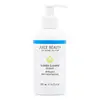What's inside
What's inside
 Key Ingredients
Key Ingredients

 Benefits
Benefits

 Concerns
Concerns

No concerns
 Ingredients Side-by-side
Ingredients Side-by-side

Citrus Limon Juice
Skin ConditioningPrunus Cerasus Juice
Skin ConditioningVitis Vinifera
MaskingAloe Barbadensis Leaf Juice
Skin ConditioningDecyl Glucoside
CleansingGlycerin
HumectantSodium Hydroxide
BufferingGluconolactone
Skin ConditioningSclerotium Gum
Emulsion StabilisingXanthan Gum
EmulsifyingLysolecithin
EmulsifyingPullulan
Sodium Benzoate
MaskingSodium Levulinate
Skin ConditioningSalvia Officinalis Extract
AntimicrobialTaraxacum Officinale Leaf Extract
Skin ConditioningMelissa Officinalis Leaf Extract
Skin ConditioningNannochloropsis Oculata Extract
HumectantHelianthus Annuus Seed Oil
EmollientTocopherol
AntioxidantTetrasodium Glutamate Diacetate
Sodium Anisate
AntimicrobialCitric Acid
BufferingCitrus Aurantifolia Oil
CleansingLitsea Cubeba Fruit Oil
MaskingCitrus Aurantium Amara Peel Oil
Skin ConditioningViola Odorata Oil
MaskingCitrus Limon Juice, Prunus Cerasus Juice, Vitis Vinifera, Aloe Barbadensis Leaf Juice, Decyl Glucoside, Glycerin, Sodium Hydroxide, Gluconolactone, Sclerotium Gum, Xanthan Gum, Lysolecithin, Pullulan, Sodium Benzoate, Sodium Levulinate, Salvia Officinalis Extract, Taraxacum Officinale Leaf Extract, Melissa Officinalis Leaf Extract, Nannochloropsis Oculata Extract, Helianthus Annuus Seed Oil, Tocopherol, Tetrasodium Glutamate Diacetate, Sodium Anisate, Citric Acid, Citrus Aurantifolia Oil, Litsea Cubeba Fruit Oil, Citrus Aurantium Amara Peel Oil, Viola Odorata Oil
 Reviews
Reviews

Ingredients Explained
These ingredients are found in both products.
Ingredients higher up in an ingredient list are typically present in a larger amount.
Citric Acid is an alpha hydroxy acid (AHA) naturally found in citrus fruits like oranges, lemons, and limes.
Like other AHAs, citric acid can exfoliate skin by breaking down the bonds that hold dead skin cells together. This helps reveal smoother and brighter skin underneath.
However, this exfoliating effect only happens at high concentrations (20%) which can be hard to find in cosmetic products.
Due to this, citric acid is usually included in small amounts as a pH adjuster. This helps keep products slightly more acidic and compatible with skin's natural pH.
In skincare formulas, citric acid can:
While it can provide some skin benefits, research shows lactic acid and glycolic acid are generally more effective and less irritating exfoliants.
Most citric acid used in skincare today is made by fermenting sugars (usually from molasses). This synthetic version is identical to the natural citrus form but easier to stabilize and use in formulations.
Read more about some other popular AHA's here:
Learn more about Citric AcidGlycerin is already naturally found in your skin. It helps moisturize and protect your skin.
A study from 2016 found glycerin to be more effective as a humectant than AHAs and hyaluronic acid.
As a humectant, it helps the skin stay hydrated by pulling moisture to your skin. The low molecular weight of glycerin allows it to pull moisture into the deeper layers of your skin.
Hydrated skin improves your skin barrier; Your skin barrier helps protect against irritants and bacteria.
Glycerin has also been found to have antimicrobial and antiviral properties. Due to these properties, glycerin is often used in wound and burn treatments.
In cosmetics, glycerin is usually derived from plants such as soybean or palm. However, it can also be sourced from animals, such as tallow or animal fat.
This ingredient is organic, colorless, odorless, and non-toxic.
Glycerin is the name for this ingredient in American English. British English uses Glycerol/Glycerine.
Learn more about GlycerinTocopherol (also known as Vitamin E) is a common antioxidant used to help protect the skin from free-radicals and strengthen the skin barrier. It's also fat soluble - this means our skin is great at absorbing it.
Vitamin E also helps keep your natural skin lipids healthy. Your lipid skin barrier naturally consists of lipids, ceramides, and fatty acids. Vitamin E offers extra protection for your skin’s lipid barrier, keeping your skin healthy and nourished.
Another benefit is a bit of UV protection. Vitamin E helps reduce the damage caused by UVB rays. (It should not replace your sunscreen). Combining it with Vitamin C can decrease sunburned cells and hyperpigmentation after UV exposure.
You might have noticed Vitamin E + C often paired together. This is because it is great at stabilizing Vitamin C. Using the two together helps increase the effectiveness of both ingredients.
There are often claims that Vitamin E can reduce/prevent scarring, but these claims haven't been confirmed by scientific research.
Learn more about Tocopherol